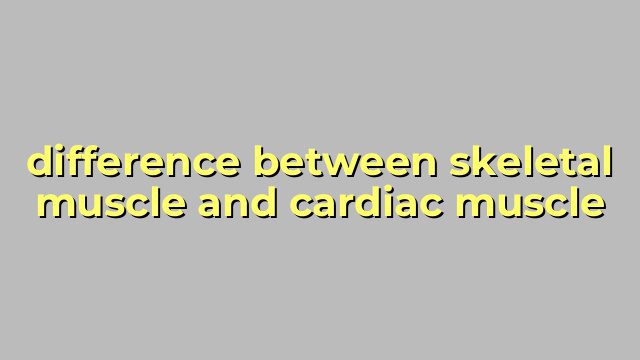The Key Differences Between Skeletal Muscle and Cardiac Muscle
When it comes to muscles, there are several different types that serve various functions in the body. Two of the most commonly known types are skeletal and cardiac muscle. While both types are important, there are some key differences that set them apart.
Skeletal Muscle
Skeletal muscle, also known as striated muscle, is attached to bones and can be consciously controlled by the body. These muscles are responsible for our ability to move and perform physical activities such as walking, lifting, and throwing. Skeletal muscle is made up of long, cylindrical cells called muscle fibers that are arranged lengthwise to create the muscle.
Some of the key characteristics of skeletal muscle include:
– Voluntary control: Skeletal muscle can be controlled by the brain, allowing us to move our bodies as we desire.
– Fatigues quickly: Skeletal muscle tires easily and needs time to recover after intense exercise.
– Can be toned and strengthened: With regular exercise, skeletal muscle can become stronger and more toned, improving overall physical fitness.
Cardiac Muscle
Cardiac muscle is a type of involuntary muscle found in the walls of the heart. Unlike skeletal muscle, cardiac muscle cannot be consciously controlled by the body. The cells in cardiac muscle are shorter and branched, creating a network that allows the heart to contract and expand in a coordinated manner.
Some of the key characteristics of cardiac muscle include:
– Involuntary control: The heart beats and pumps blood without the conscious effort or control of the body.
– Does not fatigue: Cardiac muscle is designed to work continuously without getting tired or needing a break.
– Cannot be toned or strengthened: While regular exercise is important for overall heart health, it does not strengthen or tone the cardiac muscle specifically.
The Bottom Line
Both skeletal and cardiac muscle play crucial roles in the body, and understanding the differences between the two can help us better understand how to take care of our physical health. Regular exercise is important for both types of muscle, but the ways in which they respond to exercise differ. Whether you’re looking to improve your physical fitness or simply curious about how your body works, learning about skeletal and cardiac muscle is a valuable pursuit.
Table difference between skeletal muscle and cardiac muscle
| Feature | Skeletal Muscle | Cardiac Muscle |
|---|---|---|
| Location | Attached to bones | Found in the heart |
| Structure | Long, cylindrical fibers with multiple nuclei | Branching fibers with a single nucleus |
| Contractions | Voluntary contractions under conscious control | Involuntary, rhythmic contractions controlled by pacemaker cells |
| Striations | Prominent striations | Less prominent striations |
| Mitochondria | Less mitochondria | More mitochondria |
| Gap Junctions | Very few gap junctions | Rich in gap junctions for coordinated contraction |
| Regeneration | Can regenerate and repair after injury | Cannot regenerate and repair after injury |
| Energy | Relies primarily on anaerobic metabolism for energy | Relies primarily on aerobic metabolism for energy |

